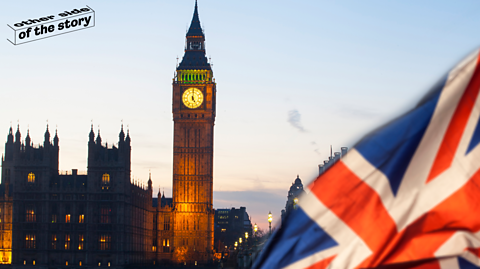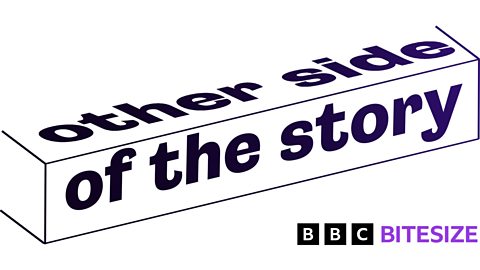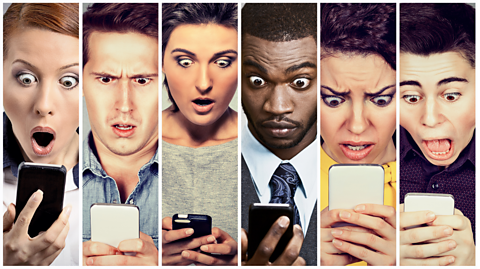
It‚Äôs already been a jam-packed summer of events, with football and politics dominating news headlines thanks to Euro 2024 and the general election. However, the usual media coverage has come with an added dimension ‚Äď AI deepfakes.
Over the past month, deepfake videos about the Euros and the elections have been shared widely on social media. This includes clips of political party leaders apparently playing Minecraft, which have collectively racked up more than 1.5 million views on TikTok, and fake videos of the England manager criticising and insulting members of his squad at a press conference.

What is a deepfake video?
- A deepfake video is a clip that has been created or modified using artificial intelligence (AI). AI is technology that enables computers or machines to learn and carry out tasks that only humans were capable of before.
- AI videos can be made for fun and comedy purposes, but can also be created to create controversy or mislead people, by changing what a celebrity or politician is doing or saying.
- Some people share such videos, unaware that they're deepfakes, but this means they could be spreading misinformation - fake news that is created and spread by mistake. Others create, publish and share the fake videos deliberately, meaning they're spreading disinformation.
- As AI technology continues to improve, the quality of these deepfake videos is also getting better. This makes it more difficult to spot the real from the deepfake, however there are certain key elements that are often a giveaway.
1. What are they saying?
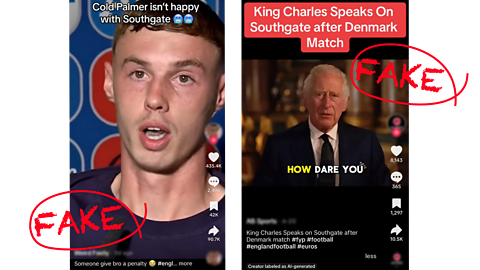
It’s pretty common for deepfake videos to feature celebrities and public figures saying something controversial or out of character.
In these two deepfake examples of England footballer Cole Palmer and King Charles, the audio and images have been manipulated to give the impression that they’re criticising England manager Gareth Southgate and the performance of the England squad in the tournament. This Cole Palmer video alone gained 1.2 million views on X and a huge 3.6 million views on TikTok.
These comments are not something you’d expect from either, so this is an immediate red flag.

2. Peculiar mouth movements
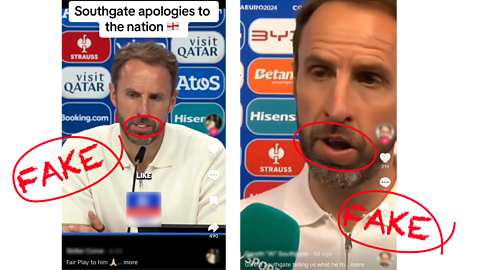
With deepfake videos, the area around the mouth and chin can be a big giveaway that the clip has been manipulated. The mouth area, including teeth, can look blurry, pixelated or of a lower quality than the rest of the video image. There might also be poor synchronisation between the person’s mouth and voice, meaning that the audio and mouth movements don’t match up.
These are screenshots from deepfake videos of Gareth Southgate at EURO 2024. Although Gareth’s voice is very similar in the clips, the area around his mouth and teeth is very pixelated and unnatural.

3. Check the source!
Another key way to check whether a video is a deepfake or real is to look at the source. This is often the social media account where the video was first published. In many cases these initial accounts will state that their videos are fake or created using AI software.
You can also check to see whether the video's caption includes #AI or #Deepfake hashtags, or whether the video has been labelled or flagged as being created using AI.
To make sure you're watching the original, unedited clip, watch on trusted news accounts or websites.
4. Apply common sense
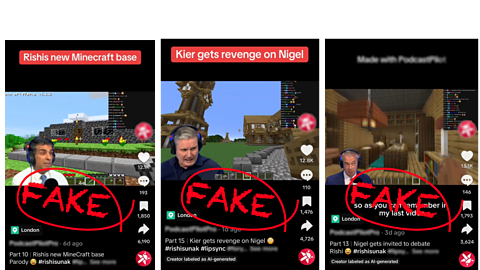
Finally, when you come across a video that seems a bit suspect, it probably is. Take the viral clips that have racked up over 1.5 million views on TikTok, which show Nigel Farage, Rishi Sunak and Sir Keir Starmer playing on a Minecraft server.
Over 166 million users play on Minecraft each month, but would these party leaders really use Minecraft to get one up on one another? What’s the probability of this happening? Common sense will tell you that it’s extremely unlikely.
Other red flags that apply to these clips include comments from the politicians that are out of character, blurred mouth movements and 'AI-generated' labels in the bottom left corners.


Not sure if the news you’re seeing on social media is true or false? Can you always tell if the things you see online are real or fake? Learn how to get the other side of the story with our quizzes, videos and explainers.

